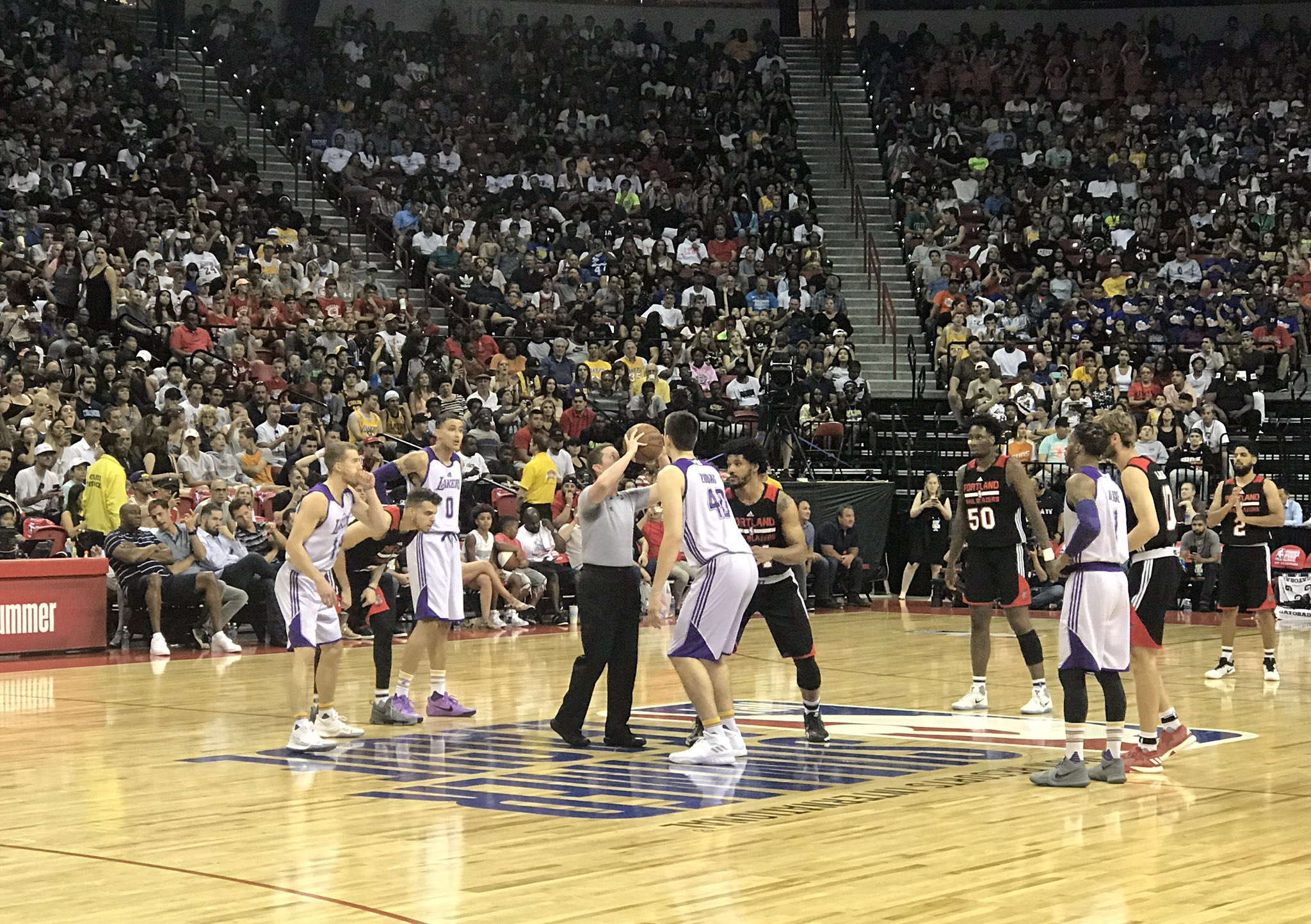Last week, arguably the most-anticipated NBA Summer League since LeBron James first appeared on the scene in 2004 concluded at the Thomas & Mack Center in Las Vegas, featuring the Los Angeles Lakers, showcasing their prized rookie phenom and shoe salesman, Lonzo Ball.
This was not the first time the Lakers found themselves in Las Vegas enveloped in the national spotlight, although the circumstances in 2017 were not even remotely as significant as they were 25 years earlier.
It was late April 1992, and the Lakers were hosting Game 3 of their first-round NBA playoff series against Portland at the Forum in Inglewood when the world literally exploded around them.
That afternoon, the four police officers captured on videotape beating motorist Rodney King a year earlier were acquitted of all charges in Simi Valley, and as the Lakers-Blazers game played out in the Forum, Los Angeles burned in the start of the worst riot the city had seen since Watts in 1965.
Throughout the history of the NBA, it has not been uncommon for teams to find themselves relocated to temporary arenas, sometimes for months, years, or several consecutive seasons. Construction delays, renovations and varying degrees of storm damage have forced teams to find a home away from home in a sport that puts the greatest stock in home-court advantage.
But none had the immediacy and urgency of what befell both the Lakers and Los Angeles Clippers in that final, horrific week of April 1992. Both teams were in the playoffs in the same year for the first time since the Clippers moved to Los Angeles from San Diego in 1984. While the Lakers were able to finish Game 3 the night the riot began, the continuing unrest forced the league to move Game 4 to the Thomas & Mack Center for Game 4, where the Blazers closed out the series with a blowout victory.
The Clippers saw their home game in Game 4 against the Utah Jazz moved to the Anaheim Convention Center, where the Clippers were able to force a deciding Game 5 before falling short of the second round.
But those were just one-game changes in venue. For the New Orleans Hornets, it would be two entire seasons in a temporary home in the wake of even greater horror and tragedy. By the summer of 2005, the Hornets had been in New Orleans for three seasons after relocating from Charlotte, playing their games at the New Orleans Arena, across the street from the Superdome.
Then, Hurricane Katrina struck. The devastation from the flooding forced the Hornets to play the majority of their home games during the 2005-06 and ’06-’07 seasons at the Ford Center in Oklahoma City. The team temporarily re-named themselves the New Orleans/Oklahoma City Hornets and defied expectations by drawing an average of 18,716 over 36 games in the first season and 17,951 over 35 games in 2006-07. The success of the Hornets’ two seasons in Oklahoma City led the NBA to approve the relocation of the Seattle Sonics to Oklahoma City for the 2008-08 season.
Weather also impacted the Detroit Pistons in 1984, although on a much smaller scale. Until the 1988-89 season, the Pistons played their home games at the Pontiac Silverdome, home of the NFL’s Lions. But for one memorable night in 1984, the Pistons were forced to play the deciding Game 5 of their first-round playoff series against the Knicks at Joe Louis Arena in downtown Detroit. The home of the Red Wings, Joe Louis became the Pistons’ refuge when a scheduling conflict forced them out of the Silverdome on April 27, 1984.
The sweltering arena — the air conditioning failed before the game — bore witness to one of the greatest games in NBA history, with Isiah Thomas remarkably scoring 16 points in the final 94 seconds of regulation to force overtime, only to see Bernard King finish off a 46-point night by scoring the deciding points on an offensive-rebound dunk.
Snow, not heat, put the Pistons back at Joe Louis in 1985. A late-winter snowstorm caused the inflatable roof of the Silverdome to collapse, forcing the Pistons back to their home away from home for the final 18 games of the season, including two playoff rounds. This time, it was Vinnie Johnson who overheated at Joe Louis, dropping 34 points on the Celtics in Game 4 of the Eastern Conference semis, earning the nickname, “The Microwave,” from an admiring opponent, Danny Ainge.
In the NBA’s modern era, six other teams played in temporary homes as they awaited completion of new, permanent arenas. (Go further back in NBA history and you’ll find teams employing temporary venues all the time, such as the Minneapolis Lakers‘ use of the Minneapolis Armory as a temporary venue when the Minneapolis Auditorium was unavailable.) The New Jersey Nets have made a lifetime of moving from building to building, playing four seasons at Rutgers’ Louis A. Brown Arena (1977-81) before settling into the Meadowlands’ Brendan Byrne Arena in 1981. They moved again in 2010, spending two years at Newark’s Prudential Center before settling into their now forever home at the Barclays Center in Brooklyn.
When the Minnesota Timberwolves entered the NBA in 1989, they played a single season at the Metrodome before Target Center opened in the 1990-1991 campaign. In an otherwise miserable season, the Timberwolves did attract national attention by drawing over a million fans that expansion season.
The Seattle Sonics played the majority of its 41 seasons at the Seattle Center Coliseum, save eight years from 1978-85 when they joined the Mariners and Seahawks in the Kingdome. But when the Coliseum underwent renovations in 1994, the Sonics played one season at the Tacoma Dome, winning 57 games in the regular season before being upset in the first round of the playoffs by the Lakers. The next year, back at newly renamed Key Arena, the Sonics reached the NBA Finals.
Two teams played in temporary arenas from 1997-99. The Toronto Raptors were born in 1993 and debuted in the league in 1995, but their current home, the Air Canada Centre, was not built until 1999, forcing the Raptors to play four seasons of home games at a baseball ballpark (SkyDome, 1995-99) and a hockey arena (Maple Leaf Gardens, 1997-99). The Atlanta Hawks also were forced to wait two years to transition from the Omni after the 1996-97 season to Philips Arena to start the 1999-2000 season, playing the intervening years at the Georgia Dome and Alexander Memorial Coliseum.
And then there’s the current NBA Champions, the Golden State Warriors, who will move to a new arena in San Francisco in 2019. The Warriors are a well-traveled team, spending their early years playing out of a variety of Bay Area venues: the Cow Palace and the San Francisco Auditorium, mainly. Since Oracle Arena opened in 1966, the Warriors have called that arena home save one season: the 1996-97 season, when the Warriors played out of San Jose Arena (now the SAP Center) while Oracle was renovated.
For what it’s worth, four days before the Warriors played their first game back at the renovated Oracle Arena, Lonzo Ball was born.
Image of NBA Summer League 2017 championship game at Thomas & Mack Center courtesy NBA.


